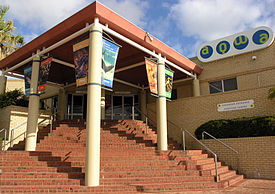AQWA
| AQWA | ||
|---|---|---|
| Full name | Aquarium of Western Australia (AQWA) | |
| particularities | largest marine aquarium in Australia | |
| place | Hillarys Boat Harbor 91 Southside Drive, Hillarys Western Australia |
|
| opening | April 13, 1988 | |
| organization | ||
|
Entrance area of the AQWA |
||
| http://www.aqwa.com.au/ | ||
|
|
||
Coordinates: 31 ° 49 ′ 36 ″ S , 115 ° 44 ′ 16 ″ O
The AQWA ( acronym for The Aquarium of Western Australia ) is Australia's largest marine aquarium . It is located in Hillarys on the Sunset Coast about 25 km north of the metropolis of Perth in the state of Western Australia .
Company history
The predecessor of today's AQWA was the marine aquarium Perth Underwater World , built between 1986 and 1987 at its current location in the port of Hillarys by Underwater World International , which was initially 40% owned by the federal development company Western Australian Development Corporation (WADC) and 60 % owned by Laurie Wilson's private Australian group of companies; both partners no longer exist in this form. The company was only able to hold the aquarium, which opened on April 13, 1988, for three years. Initially, the development company took over all of the shares in the Wilson group, which had become “ailing”, and in September 1991 the complex was up for sale at a loss.
The buyer was Coral World International Ltd. ; Behind this company is the Israeli billionaire Morris Kahn , who founded it in the mid-1970s together with the American-Israeli company Ampal led by Jacob Levinson . Morris Kahn's investments are actually in the software, media and telecommunications industries, but the entrepreneur was an avid diver at a young age, and his business idea of creating a chain of marine aquariums around the world was personally motivated. There are facilities similar to those in Perth in Eilat , the US Virgin Islands , the Bahamas , Manly and Hawaii .
Coral World initially retained the name of its predecessor in Perth; in January 2001, however, the complex was renamed to its current name AQWA after renovation work.
The current website (as of 2007), which does not list the previous history, suggests to the reader that the company's success with 5 million visitors in 19 years of company history is based solely on the personality of Morris Kahn. However, the forerunner was already awarded three awards from the tourism authority from 1988-1991.
The aquarium
In the AQWA, the Western Australian underwater world is documented on 12,000 km of coastline in five sections / climatic zones with 400 species:
- Cool temperate south coast from Eucla to Fremantle
- Sunset Coast north of Perth
- Warm temperate Batavia Coast from Lancelin to Shark Bay
- Subtropical Coral Coast from Ningaloo Reef to Exmouth
- Tropical northwest coast along the Kimberley region to Kununurra
A large number of ray fins are presented as representatives of the cool, temperate zone with Antarctic currents . The sea dragon , which only occurs on the South Australian coast, is also shown.
The waters of the Sunset Coast are protected by the 10,000 hectare Marmion Marine Park established in 1987 . Small shark species, rays , snake eels , moray eels , rainbow fish , wrasse , boxfish and butterfly fish are typical species that inhabit the area.
From the Batavia Coast area, the most spectacular of the animals featured are the great sand tiger shark , loggerhead sea turtle and eagle ray .
Corals in diverse species and colorful fish species are the subject of the subtropical zone. The whale shark is explained as the king of the seas around Exmouth through documentation boards.
For the tropical far north some extremely poisonous animal species are declared in a special danger zone. Stingrays and velvet fish are examples. You can also see small crocodiles .

Leather coral from the tropical north coast
|
concept
To keep the people captive - not the animals is the company's motto in its self-presentation on the website. A 98 m long acrylic glass tunnel leads through the central aquarium, which holds 3 million liters of water on an area of 800 m² and where fresh water is exchanged every day using filtered seawater. The visitor crosses it with the feeling of being in the middle of the underwater world. In addition to its counterpart in Eilat, this is the longest of its kind in the world.
Around this central aquarium there are a number of exhibition rooms with smaller tanks. An area for sea lions is designed so that the animals can move freely between a large pool and a rocky open space in the outside area. There are also some pools in which starfish , sea urchins , crabs and mussels can be touched ( touching pool ), which is an attraction especially for families with children.
Coral World claims species-appropriate animal husbandry in its aquariums, but - in contrast to the European sea-life concept, for example - does not see itself as an active animal welfare program. Coral World has made it possible to keep larger shark species in the aquarium, which Merlin Entertainment expressly rejects for its sea-life facilities. However, the dimensions are not comparable either; For example, the 10 m long acrylic glass tunnel in Sea Life Königswinter is only 1/10 the size of the one at AQWA in Perth.
The museum also has a restaurant and a book and souvenir shop.
literature
AQWA Guidebook , ed. by Darren Jew (self-published by Living Image), Sandgate / Queensland 2005





